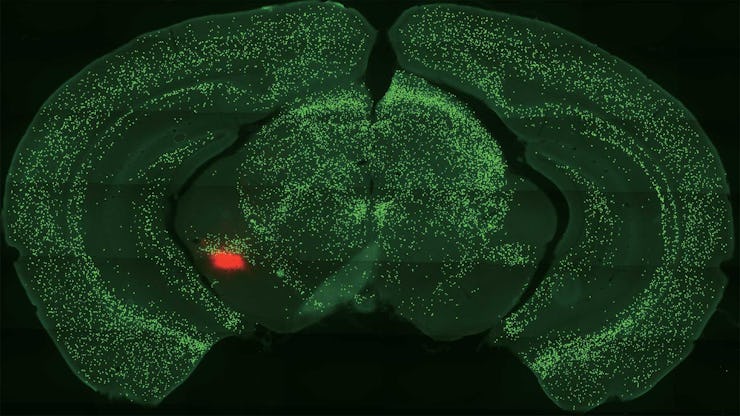Novel Research on How Mice Perceive Pleasure Reveals a Promising Path to Treating Addiction
The amygdala is smarter than we give it credit for.

If you’ve ever assigned a special ringtone to a crush, you know the instant hit of dopamine that occurs the instant it goes off. You might also know the feeling when another ringtone goes off for a person you are avoiding.
One part of the brain that processes and internalizes these conditioned responses is the amygdala, a set of two almond-shaped structures deep in the brain’s temporal lobes that mediate learning, memory, dopamine release, and the fight-or-flight response. While humans can learn to interpret two stimuli differently based on what they signal, neuroscientists generally believed that neurons within the amygdala couldn’t distinguish them — they were simply stimuli, neither positive nor negative. But it turns out brain cells are smarter than we give them credit for.
In an experiment involving mice, researchers at Cold Spring Harbor Laboratory found that cells in the amygdala fire in distinct ways in response to various learned cues.
“This kind of opened up a new way of thinking of neurons in the central amygdala,” senior author Bo Li, a neuroscience professor at Cold Spring Harbor Laboratory, tells Inverse.
Their results, published on April 5 in the journal Nature, provides a new window into the inner workings of the amygdala. The authors suggest this new information might even help treat the various brain changes involved in drug addiction.
Sound cues for Algernon
For the experiment, Li and his team conditioned mice to certain sound cues. The researchers would play various tones at different frequencies and then provide a different reward for each sound (plain food, plain water, fat- or protein-enriched food, sugar water) or a punishment (a small shock to the tail or a puff of air in the face).
Then they conducted neuroimaging to see how those specific central amygdala neurons — known as somatostatin-expressing central amygdala neurons (somatostatin is a peptide hormone that regulates the endocrine system) — behaved in response to the various sounds. These particular neurons comprise about half of the central amygdala, which is why the team took a close look at those cells’ activity.
They found the mice could anticipate from simple sound stimuli the difference between a good and great reward or an okay or bad one. These responses surprisingly resemble those of neurons in sensory parts of the brain, like the auditory cortex. The information Li and his team found comes with a particular stimulus that affects the animal’s survival, such as whether it heralds food or an electrical shock. So not only could the amygdala’s brain cells discern positive from negative, but they could also perceive gradations. While the brain will register a sound-signaling food as a good thing, these neurons fire differently if it’s a sound for plain food, which is fine, and fat-enriched food, which is great.
The researchers found that once these mice were conditioned, the neurons in the amygdala fired even more intensely. Next, Li and his team wondered what would happen if they inhibited activity in these brain cells. When they did this, the mice’s learning was impaired. What’s more, a dopamine response was suppressed.
“We know dopamine [is] critical for reward learning, and therefore reward learning will be also impaired,” Li says.
Interrupting this reward learning ability makes it harder to create positive associations between certain cues and desirable outcomes.
Addiction recovery applications
While this discovery makes for one more puzzle piece in the infinitely complex human brain, its applications could aid in treating drug addiction.
When these neurons were inhibited, normal dopamine responses also went silent. Feel-good dopamine is what helps us learn, creating associations between a stimulus and its outcome — for example, a ringtone and your crush.
“The hypothesis is that drug addiction can have an influence on this neuron, causing this neuron to be in an active state,” Li says. This activity will promote dopamine release. Theoretically, by creating a pill that inhibits these neurons, there would be no activity and, therefore, no dopamine release.
What’s next for the amygdala
So far, Li has only looked at these neurons in healthy mice. The next step is to observe the neurons of a subject with a disease like drug addiction. Those brain cells could act atypically, shedding even more light on possible interventions. By understanding how the amygdala responds to outer cues to create associations with positive or negative outcomes, researchers may be able to disrupt learned connections with drug use. If these neurons are suppressed, then they won’t release dopamine, which erases the link between good feelings and drug use.
“Maybe,” Li says, “that can be utilized to treat or prevent drug addiction.”
This article was originally published on